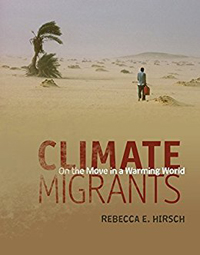 Rebecca E. Hirsch, Climate Migrants: On the Move in a Warming World (Minneapolis: Twenty-First Century Books, 2017), 88pp.
Rebecca E. Hirsch, Climate Migrants: On the Move in a Warming World (Minneapolis: Twenty-First Century Books, 2017), 88pp.
In Alaska, entire islands are vanishing because of the melting permafrost and perennial sea ice. Some of the thirty-three tiny islands of the nation of Kiribati are already completely submerged under rising sea levels. On other islands, the farm land and drinking water have been poisoned by sea water. In the next 25 years, 40-50 island nations will totally disappear.
The Sahel desert of north-central Africa is home to 100 million people, but droughts, famine, and violence have already displaced 2.8 million people.
And here in the United States? Professor Hal Wanless of the University of Miami says that he "cannot envision southeastern Florida having many people at the end of the century." Hurricane Sandy in 2012 displaced 776,000 residents and damaged or destroyed 650,000 homes. Some of those displaced people moved, others returned, and many are still homeless. Hurricane Katrina in 2005 was the costliest natural disaster in American history.
What all these different stories and places have in common is one of the many consequences of climate change — the forced relocation of millions of people. These involuntary migrations raise all sorts of questions about national security, cost-sharing, resettlement programs, etc. In New Zealand in 2014, a family from the island nation of Tuvalu was granted asylum as climate refugees. The hardest hit peoples are often the poorest, who in many instances have contributed the least to climate change.
By the year 2050, writes Rebecca Hirsch, some 25 million people will become involuntary migrants due to climate changes. Their homes and lands will be uninhabitable.
Hirsch humanizes all these facts and figures by telling the personal stories of families all over the world. She supplements these stories with photographs, maps, and graphs. A final chapter considers the future of climate migration and possible responses. For more on this urgent subject, see the movie Climate Refugees (2009), the book by Jared Diamond, Collapse; How Societies Choose to Fail or Succeed (2005), and the article in the New Yorker called "Miami is Flooding" (December 21, 2015).


